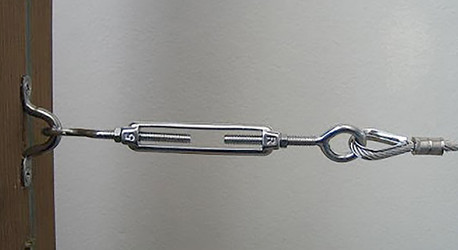What Are Turnbuckles
Posted by Chain Direct on 5th Aug 2021
Turnbuckles area a common rigging device that is used to adjust tension and reduce slack in a rope or cable, and are commonly used in a variety of applications across many different industries, from applications as simple as providing tension in balustrade wire, or heavy-duty applications like the construction of a suspension bridge.
At Chain Direct, we have a range of stainless steel turnbuckles that are designed for use with balustrade installations.
All the turnbuckles in our range are Stainless Steel Maine Grade 316, and all sizes have locking nuts, which is most important apart from the fact that various authorities specify this feature as essential.
These are available in a number different sizes and end fitting types that allow for flexibility of design and construction when assembling your balustrade wire.
So, what is a Turnbuckle?
Basically, a turnbuckle is a piece of hardware that is used to eliminate slack and adjust tension in a cable.
The end fitting on either side of a turnbuckle connects to the cable and mounting point, where the turnbuckle can be tightened or loosened to adjust tension as required. This allows for easy set-up, installation and maintenance.
The body of the turnbuckle is a type of metal frame that joins the two threaded end fittings and can be turned to adjust tension by extending and retracting the end fittings.
The body type can be a closed or open design, where an open body turnbuckle is the more traditional type where the threads are visible through the body frame.
The end fittings are the two connection points that screw into the opposite ends of the turnbuckle body. One end fitting is right-hand threaded while the other is left-hand threaded. This allows you to turn the body to adjust tension after installation without moving the end fittings.
There are three main types of end fittings that can be used together in any combination on either end of the turnbuckle, these are:
Hook end, which is a hook shape fitting and are the easiest to use as they allow for quick connection and disconnection.
Eye end, which is a closed loop shape fitting that can be connected using a shackle, quick link or looping the wire and swaging in into place.
Jaw end, these are more commonly found on rigging screws, which are a form of turnbuckle. A jaw end fitting consists of a jaw and bolt secured together by a nut or a pin.
The end fittings can be used in a combination of types, for example, you can have a hook on one end and an eye on the other. This allows for greater flexibility of design and construction of your balustrade wire or rigging jobs.
The combination of end fittings is usually determined by what the turnbuckles need to connect too and whether the solution is permanent or temporary.
When planning your balustrade job and the use of turnbuckles, you need to consider the take-up length of the turnbuckle. This is the total length that the end fittings can screw into and out of the body to take-up or release the tension. The take-up length can be measured in terms of opened or closed, where the end fittings of the turnbuckle are either fully extended or fully retracted.
We have a great range of turnbuckles and balustrade kits and packages in stock, so check out our range here.

